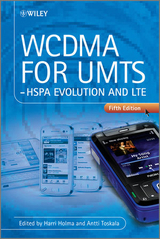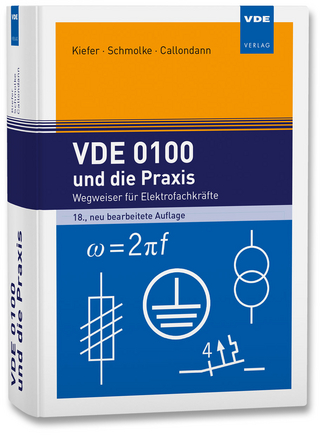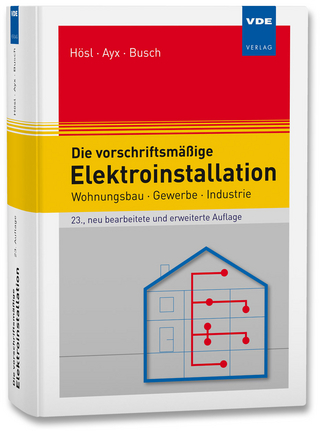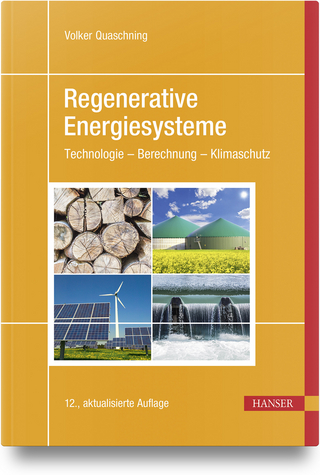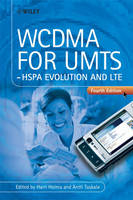
WCDMA for UMTS
Wiley-Blackwell (Verlag)
978-0-470-31933-8 (ISBN)
- Titel erscheint in neuer Auflage
- Artikel merken
Written by the leading experts in the field, the best selling book on UMTS is now updated to cover 3GPP High Speed Packet Access (HSPA) evolution (HSPA+) in Release 7 and on-going Long Term Evolution (LTE) activity for Release 8. These technologies enhance the capabilities of the existing WCDMA/HSPA networks to offer higher data rates beyond 100 Mbps."WCDMA for UMTS, Fourth Edition" also covers 3GPP WCDMA Release 99, High Speed Downlink Packet Access (HSDPA) in Release 5 and High Speed Uplink Packet Access (HSUPA) in Release 6, which are already deployed commercially. Multimedia Broadcast Multicast System (MBMS) is also described in detail. Key updates include: Continues to provide both updated descriptions of the 3GPP standard as well as the latest end user and system performance estimates; updated HSDPA and HSUPA, including link budgets and Iub dimensioning; detailed MBMS description 3GPP Release 7 HSPA evolution full description 3GPP Release 8; LTE overall description and 3GPP schedule; and dedicated chapter on terminal design challenges for the new high speed radio technologies.
Preface. Acknowledgements. Abbreviations. 1 Introduction (Harri Holma and Antti Toskala). 1.1 WCDMA in Third-Generation Systems. 1.2 Spectrum Allocations for Third-Generation Systems. 1.3 Requirements for Third-Generation Systems. 1.4 WCDMA and its Evolution. 1.5 System Evolution. References. 2 UMTS Services (Harri Holma, Martin Kristensson, Jouni Salonen and Antti Toskala). 2.1 Introduction. 2.2 Person-to-Person Circuit Switched Services. 2.2.1 AMR-NB and AMR-WB Speech Services. 2.2.2 Video Telephony. 2.3 Person-to-Person Packet Switched Services. 2.3.1 Messaging. 2.3.2 Push-to-Talk over Cellular. 2.3.3 Voice over IP. 2.3.4 Multiplayer Games. 2.4 Content-to-Person Services. 2.4.1 Browsing. 2.4.2 Audio and Video Streaming. 2.4.3 Content Download. 2.5 Business Connectivity. 2.6 Location Services. 2.6.1 Cell-Coverage-Based Location Calculation. 2.6.2 Assisted GPS. 2.7 QoS Differentiation. 2.8 Capacity and Cost of Service Delivery. 2.8.1 Capacity per Subscriber. 2.8.2 Cost of Voice and Data Delivery. 2.9 Summary. References. 3 Introduction to WCDMA (Peter Muszynski and Harri Holma). 3.1 Introduction. 3.2 Summary of the Main Parameters in WCDMA. 3.3 Spreading and Despreading. 3.4 Multipath Radio Channels and Rake Reception. 3.5 Power Control. 3.6 Softer and Soft Handovers. References. 4 Background and Standardisation of WCDMA (Antti Toskala). 4.1 Introduction. 4.2 Background in Europe. 4.2.1 Wideband CDMA. 4.2.2 Wideband TDMA. 4.2.3 Wideband TDMA/CDMA. 4.2.4 OFDMA. 4.2.5 ODMA. 4.2.6 ETSI Selection. 4.3 Background in Japan. 4.4 Background in Korea. 4.5 Background in the United States. 4.5.1 W-CDMA N/A. 4.5.2 UWC-136. 4.5.3 cdma2000. 4.5.4 TR46.1. 4.5.5 WP-CDMA. 4.6 Creation of 3GPP. 4.7 How does 3GPP Operate? 4.8 Creation of 3GPP2. 4.9 Harmonisation Phase. 4.10 IMT-2000 Process in ITU. 4.11 Beyond 3GPP Release 99. References. 5 Radio Access Network Architecture (Fabio Longoni, Atte La nsisalmi and Antti Toskala). 5.1 System Architecture. 5.2 UTRAN Architecture. 5.2.1 The Radio Network Controller. 5.2.2 The Node B (Base Station). 5.3 General Protocol Model for UTRAN Terrestrial Interfaces. 5.3.1 General. 5.3.2 Horizontal Layers. 5.3.3 Vertical Planes. 5.4 Iu, the UTRAN-CN Interface. 5.4.1 Protocol Structure for Iu CS. 5.4.2 Protocol Structure for Iu PS. 5.4.3 RANAP Protocol. 5.4.4 Iu User Plane Protocol. 5.4.5 Protocol Structure of Iu BC, and the Service Area. Broadcast Protocol. 5.5 UTRAN Internal Interfaces. 5.5.1 RNC-RNC Interface (Iur Interface) and the RNSAP Signalling. 5.5.2 RNC-Node B Interface and the NBAP Signalling. 5.6 UTRAN Enhancements and Evolution. 5.6.1 IP Transport in UTRAN. 5.6.2 Iu Flex. 5.6.3 Stand-Alone SMLC and Iupc Interface. 5.6.4 Interworking Between GERAN and UTRAN, and the Iur-g Interface. 5.6.5 IP-Based RAN Architecture. 5.7 UMTS CN Architecture and Evolution. 5.7.1 Release 99 CN Elements 5.7.2 Release 5 CN and IP Multimedia Subsystem. References. 6 Physical Layer (Antti Toskala). 6.1 Introduction. 6.2 Transport Channels and their Mapping to the Physical Channels. 6.2.1 Dedicated Transport Channel. 6.2.2 Common Transport Channels. 6.2.3 Mapping of Transport Channels onto the Physical Channels. 6.2.4 Frame Structure of Transport Channels. 6.3 Spreading and Modulation. 6.3.1 Scrambling. 6.3.2 Channelisation Codes. 6.3.3 Uplink Spreading and Modulation. 6.3.4 Downlink Spreading and Modulation. 6.3.5 Transmitter Characteristics. 6.4 User Data Transmission. 6.4.1 Uplink Dedicated Channel. 6.4.2 Uplink Multiplexing. 6.4.3 User Data Transmission with the Random Access Channel. 6.4.4 Uplink Common Packet Channel. 6.4.5 Downlink Dedicated Channel. 6.4.6 Downlink Multiplexing. 6.4.7 Downlink Shared Channel. 6.4.8 Forward Access Channel for User Data Transmission. 6.4.9 Channel Coding for User Data. 6.4.10 Coding for TFCI Information. 6.5 Signalling. 6.5.1 Common Pilot Channel (CPICH). 6.5.2 Synchronisation Channel (SCH). 6.5.3 Primary Common Control Physical Channel (Primary CCPCH). 6.5.4 Secondary Common Control Physical Channel (Secondary CCPCH). 6.5.5 Random Access Channel (RACH) for Signalling Transmission. 6.5.6 Acquisition Indicator Channel (AICH). 6.5.7 Paging Indicator Channel (PICH). 6.6 Physical Layer Procedures. 6.6.1 Fast Closed-Loop Power Control Procedure. 6.6.2 Open-Loop Power Control. 6.6.3 Paging Procedure. 6.6.4 RACH Procedure. 6.6.5 Cell Search Procedure. 6.6.6 Transmit Diversity Procedure. 6.6.7 Handover Measurements Procedure. 6.6.8 Compressed Mode Measurement Procedure. 6.6.9 Other Measurements. 6.6.10 Operation with Adaptive Antennas. 6.6.11 Site Selection Diversity Transmission. 6.7 Terminal Radio Access Capabilities. 6.8 Conclusions. References. 7 Radio Interface Protocols (Jukka Viale-n and Antti Toskala). 7.1 Introduction. 7.2 Protocol Architecture. 7.3 The Medium Access Control Protocol. 7.3.1 MAC Layer Architecture. 7.3.2 MAC Functions. 7.3.3 Logical Channels. 7.3.4 Mapping Between Logical Channels and Transport Channels. 7.3.5 Example Data Flow Through the MAC Layer. 7.4 The Radio Link Control Protocol. 7.4.1 RLC Layer Architecture. 7.4.2 RLC Functions. 7.4.3 Example Data Flow Through the RLC Layer. 7.5 The Packet Data Convergence Protocol. 7.5.1 PDCP Layer Architecture. 7.5.2 PDCP Functions. 7.6 The Broadcast/Multicast Control Protocol. 7.6.1 BMC Layer Architecture. 7.6.2 BMC Functions. 7.7 Multimedia Broadcast Multicast Service. 7.8 The Radio Resource Control Protocol. 7.8.1 RRC Layer Logical Architecture. 7.8.2 RRC Service States. 7.8.3 RRC Functions and Signalling Procedures. 7.9 Early UE Handling Principles. 7.10 Improvements for Call Setup Time Reduction. References. 8 Radio Network Planning (Harri Holma, Zhi-Chun Honkasalo, Seppo Ha ma la inen, Jaana Laiho, Kari Sipila and Achim Wacker). 8.1 Introduction. 8.2 Dimensioning. 8.2.1 Radio Link Budgets. 8.2.2 Load Factors. 8.2.3 Capacity Upgrade Paths. 8.2.4 Capacity per km2. 8.2.5 Soft Capacity. 8.2.6 Network Sharing. 8.3 Capacity and Coverage Planning and Optimisation. 8.3.1 Iterative Capacity and Coverage Prediction. 8.3.2 Planning Tool. 8.3.3 Case Study. 8.3.4 Network Optimisation. 8.4 GSM Co-planning. 8.5 Inter-operator Interference. 8.5.1 Introduction. 8.5.2 Uplink versus Downlink Effects. 8.5.3 Local Downlink Interference. 8.5.4 Average Downlink Interference. 8.5.5 Path Loss Measurements. 8.5.6 Solutions to Avoid Adjacent Channel Interference. 8.6 WCDMA Frequency Variants. 8.7 UMTS Refarming to GSM900 Band. 8.7.1 3GPP Blocking Requirements. 8.7.2 Uncoordinated GSM900 t UMTS900. 8.7.3 Coordinated GSM900 t UMTS900. 8.7.4 Remaining GSM900 Voice Capacity. References. 9 Radio Resource Management (Harri Holma, Klaus Pedersen, Jussi Reunanen, Janne Laakso and Oscar Salonaho). 9.1 Interference-Based Radio Resource Management. 9.2 Power Control. 9.2.1 Fast Power Control. 9.2.2 Outer Loop Power Control. 9.3 Handovers. 9.3.1 Intra-frequency Handovers. 9.3.2 Inter-system Handovers between WCDMA and GSM. 9.3.3 Inter-frequency Handovers within WCDMA. 9.3.4 Summary of Handovers. 9.4 Measurement of Air Interface Load. 9.4.1 Uplink Load. 9.4.2 Downlink Load. 9.5 Admission Control. 9.5.1 Admission Control Principle. 9.5.2 Wideband Power-based Admission Control Strategy. 9.5.3 Throughput-Based Admission Control Strategy. 9.6 Load Control (Congestion Control). References. 10 Packet Scheduling (Jeroen Wigard, Harri Holma, Renaud Cuny, Nina Madsen, Frank Frederiksen and Martin Kristensson). 10.1 Transmission Control Protocol (TCP). 10.2 Round Trip Time. 10.3 User-specific Packet Scheduling. 10.3.1 Common Channels (RACH/FACH). 10.3.2 Dedicated Channel (DCH). 10.3.3 Downlink Shared Channel (DSCH). 10.3.4 Uplink Common Packet Channel (CPCH). 10.3.5 Selection of Transport Channel. 10.3.6 Paging Channel States. 10.4 Cell-specific Packet Scheduling. 10.4.1 Priorities. 10.4.2 Scheduling Algorithms. 10.4.3 Packet Scheduler in Soft Handover. 10.5 Packet Data System Performance. 10.5.1 Link Level Performance. 10.5.2 System Level Performance. 10.6 Packet Data Application Performance. 10.6.1 Introduction to Application Performance. 10.6.2 Person-to-person Applications. 10.6.3 Content-to-person Applications. 10.6.4 Business Connectivity. 10.6.5 Conclusions on Application Performance. References. 11 Physical Layer Performance (Harri Holma, Jussi Reunanen, Leo Chan, Preben Mogensen, Klaus Pedersen, Kari Horneman, Jaakko Vihria la and Markku Juntti). 11.1 Introduction. 11.2 Cell Coverage. 11.2.1 Uplink Coverage. 11.2.2 Downlink Coverage. 11.3 Downlink Cell Capacity. 11.3.1 Downlink Orthogonal Codes. 11.3.2 Downlink Transmit Diversity. 11.3.3 Downlink Voice Capacity. 11.4 Capacity Trials. 11.4.1 Single Cell Capacity Trials. 11.4.2 Multicell Capacity Trials. 11.4.3 Summary. 11.5 3GPP Performance Requirements. 11.5.1 Eb=N0 Performance. 11.5.2 RF Noise Figure. 11.6 Performance Enhancements. 11.6.1 Smart Antenna Solutions. 11.6.2 Multiuser Detection. References. 12 High-Speed Downlink Packet Access (Antti Toskala, Harri Holma, Troels Kolding, Preben Mogensen, Klaus Pedersen and Jussi Reunanen). 12.1 Release 99 WCDMA Downlink Packet Data Capabilities. 12.2 HSDPA Concept. 12.3 HSDPA Impact on Radio Access Network Architecture. 12.4 Release 4 HSDPA Feasibility Study Phase. 12.5 HSDPA Physical Layer Structure. 12.5.1 High-Speed Downlink Shared Channel (HS-DSCH). 12.5.2 High-speed Shared Control Channel (HS-SCCH). 12.5.3 Uplink High-speed Dedicated Physical Control Channel (HS-DPCCH). 12.5.4 HSDPA Physical Layer Operation Procedure. 12.6 HSDPA Terminal Capability and Achievable Data Rates. 12.7 Mobility with HSDPA. 12.7.1 Measurement Event for Best Serving HS-DSCH Cell. 12.7.2 Intra-Node B HS-DSCH to HS-DSCH Handover. 12.7.3 Inter-Node-Node B HS-DSCH to HS-DSCH Handover. 12.7.4 HS-DSCH to DCH Handover. 12.8 HSDPA Performance. 12.8.1 Factors Governing Performance. 12.8.2 Spectral Efficiency, Code Efficiency and Dynamic Range. 12.8.3 User Scheduling, Cell Throughput and Coverage. 12.8.4 HSDPA Network Performance with Mixed Non-HSDPA and HSDPA Terminals. 12.9 HSPA Link Budget. 12.10 HSDPA Iub Dimensioning. 12.11 HSPA Round-Trip Time. 12.12 Terminal Receiver Aspects. 12.13 Evolution in Release 6. 12.14 Conclusions. References. 13 High-Speed Uplink Packet Access (Antti Toskala, Harri Holma and Karri Ranta-aho). 13.1 Release 99 WCDMA Downlink Packet Data Capabilities. 13.2 HSUPA Concept. 13.3 HSUPA Impact on Radio Access Network Architecture. 13.3.1 HSUPA Iub operation. 13.4 HSUPA Feasibility Study Phase. 13.5 HSUPA Physical Layer Structure. 13.6 E-DCH and Related Control Channels. 13.6.1 Enhanced Dedicated Physical Data Channel (E-DPDCH). 13.6.2 Enhanced Dedicated Physical Control Channel (E-DPCCH). 13.6.3 E-DCH Hybrid ARQ Indicator Channel (E-HICH). 13.6.4 E-DCH Relative Grant Channel (E-RGCH). 13.6.5 E-DCH Absolute Grant Channel (E-AGCH). 13.7 HSUPA Physical Layer Operation Procedure. 13.7.1 HSUPA and HSDPA Simultaneous Operation. 13.8 HSUPA Terminal Capability. 13.9 HSUPA Performance. 13.9.1 Increased Data Rates. 13.9.2 Physical Layer Retransmission Combining. 13.9.3 Node B-Based Scheduling. 13.9.4 HSUPA Link Budget Impact. 13.9.5 Delay and QoS. 13.9.6 Overall Capacity. 13.10 Conclusions. References. 14 Multimedia Broadcast Multicast Service. Harri Holma, Martin Kristensson and Jorma Kaikkonen. 14.1 Multimedia Broadcast Multicast Service Concept. 14.2 MBMS Impact on Network Architecture. 14.3 High-Level MBMS Procedures. 14.4 MBMS Radio Interface Channel Structure. 14.4.1 Logical Channels. 14.4.2 Transport Channels. 14.4.3 Physical Channels. 14.4.4 Point-to-Point and Point-to-Multipoint Connections. 14.4.5 Example Radio Interface Procedure During MBMS Session Start. 14.5 MBMS Terminal Capability. 14.5.1 Selective Combining and Soft Combining. 14.6 MBMS Performance. 14.6.1 The 3GPP Performance Requirements. 14.6.2 Simulated MBMS Cell Capacity. 14.6.3 Iub Transport Capacity. 14.7 MBMS Deployment and Use Cases. 14.8 Benchmarking of MBMS with DVB-H. 14.9 3GPP MBMS Evolution in Release 7. 14.10 Summary. References. 15 High-Speed Packet Access Evolution (HSPA+) in 3GPP Release 7 (Harri Holma, Antti Toskala, Karri Ranta-aho, Juho Pirskanen and Jorma Kaikkonen). 15.1 Introduction. 15.2 Setup Time Reduction. 15.3 Peak Data Rate Increase with MIMO and 16QAM/64QAM. 15.4 Layer 2 Optimisation. 15.5 Throughput Evolution with Enhanced Terminals. 15.6 Mobile Power Consumption Reduction with Continuous Packet Connectivity. 15.7 Voice-over-IP (VoIP) Capacity Enhancements. 15.8 Flat Architecture. 15.9 Summary. References. 16 UTRAN Long-Term Evolution. Antti Toskala and Harri Holma. 16.1 Background. 16.2 Multiple Access and Architecture Decisions. 16.3 LTE Impact on Network Architecture. 16.4 LTE Multiple Access. 16.4.1 OFDMA Principles. 16.4.2 SC-FDMA Principles. 16.5 LTE Physical Layer Design and Parameters. 16.6 LTE Protocols. 16.7 Performance. 16.7.1 Peak Bit Rates. 16.7.2 Spectral Efficiency. 16.7.3 Link Budget and Coverage. 16.8 Summary. References. 17 UTRA TDD Modes (Antti Toskala, Harri Holma, Otto Lehtinen and Heli Va a ta ja ). 17.1 Introduction. 17.1.1 Time Division Duplex (TDD). 17.1.2 Differences in the Network-Level Architecture. 17.2 UTRA TDD Physical Layer. 17.2.1 Transport and Physical Channels. 17.2.2 Modulation and Spreading. 17.2.3 Physical Channel Structures, Slot and Frame Format. 17.2.4 UTRA TDD Physical Layer Procedures. 17.3 UTRA TDD Interference Evaluation. 17.3.1 TDD-TDD Interference. 17.3.2 TDD and FDD Coexistence. 17.3.3 Unlicensed TDD Operation. 17.3.4 Conclusions on UTRA TDD Interference. 17.4 HSDPA Operation with TDD. 17.5 Release 7 TDD Enhancements. 17.6 Concluding Remarks and Future Outlook on UTRA TDD. References. 18 Terminal Radio-Frequency Design Challenges (Laurent Noe l, Antti Toskala and Dominique Brunel). 18.1 Introduction. 18.2 Transmitter Chain System Design Challenges. 18.2.1 The Adjacent Channel Leakage Ratio/Power Consumption Trade-off. 18.2.2 Phase Discontinuity. 18.3 Receiver Chain Design Challenges. 18.3.1 UE Reference Sensitivity System Requirements. 18.3.2 Inter-Operator Interference. 18.3.3 Impact of RF Impairments on HSDPA System Performance. 18.4 Multi-Mode/Band Challenges. 18.4.1 From Mono-Mode/Mono-Band to Multi-Mode/Multi-Band and Diversity. 18.4.2 New Requirements due to Coexistence. 18.4.3 Front-End Integration Strategies and Design Trends. 18.4.4 Impact on Today's Architectures. 18.5 Conclusions. References. Index.
| Erscheint lt. Verlag | 1.11.2007 |
|---|---|
| Zusatzinfo | Illustrations |
| Verlagsort | Hoboken |
| Sprache | englisch |
| Maße | 175 x 253 mm |
| Gewicht | 1238 g |
| Einbandart | gebunden |
| Themenwelt | Technik ► Elektrotechnik / Energietechnik |
| ISBN-10 | 0-470-31933-X / 047031933X |
| ISBN-13 | 978-0-470-31933-8 / 9780470319338 |
| Zustand | Neuware |
| Informationen gemäß Produktsicherheitsverordnung (GPSR) | |
| Haben Sie eine Frage zum Produkt? |
aus dem Bereich
